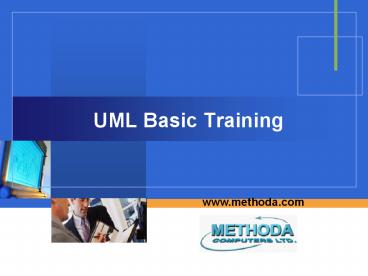UML Basic Training PowerPoint PPT Presentation
1 / 36
Title: UML Basic Training
1
UML Basic Training
www.methoda.com
2
Agenda
- Definitions requirements, design
- Basics of Unified Modeling Language 1.4
- SysML extensions
3
Definitions
- Requirement
- A description of the behavior of the system or
part of the system (sub-system, component) or a
property of it - Design
- A representation (model) that describes how
something is going to be built
All models are wrong. Some are useful
George Box
4
Types of RD Engineering Activities
System modeling SysML
Requirements definition management
SW modeling UML
HW modeling VHDL, CAD,
SysML extends UML in order to support all system
engineering methodology
5
The Basic Development Process
- Requirements
- High level (system view)
- Review
- Detailed (per feature) Use case models
- Review
- Design
- High level (system view) Design models
- Detailed (per unit/class/interface)
- Code
6
Object Oriented Analysis and Design
OOA Model of requirements (user view)
OOD Model of design (developer view)
7
UML - Unified Modeling Language
- A graphical language for visualizing the
structure and behavior of systems and systems
parts - Not a methodology. A language
- Provides notation (symbols) and meaning
(semantics) - Developed by Object Management Group (OMG)
- Supported by many tools
8
Diagram Types in UML 1.x
- Class, Object, Component
- Package
- Deployment
- Use case
- Sequence
- Activity
- Collaboration
- State chart
9
Static and Dynamic Models
- Static (structure)
- Class, Object, Component
- Package
- Deployment
- Dynamic (behavior)
- Use case
- Activity
- Sequence
- Collaboration
- State chart
10
Use Case Diagram
11
Use cases (UC)
- External view of the system
- Expressed in user terms
- Use case is used by an actor
- Actor is not necessarily human. Can be other
systems - Use case can
- ltltinclude/usegtgt other use case
- ltltextendgtgt other use case
- Each UC is described using an activity diagram or
sequence diagram
12
Use Case Documentation
- Title (goal)
- Short description
- Actors
- Trigger
- Pre-condition
- Post-condition
- Normal flow (steps)
- Using text and/or activity diagrams
- Exceptional/alternate flows
13
Activity diagram
- Describes logic of flow/process, sequence of
actions
(see later SysML extensions for activity
diagrams)
14
Class Diagram
Association
Generalization
15
Class Diagram Terms
- Class
- Name
- Attributes
- Operations
- Visibility public (), Private (-), Protected ()
16
Class Diagram Terms
- Relationships
- Dependency
- Change to one may cause change to other
- Association
- Connection exists between classes/objects
- Generalization
- Abstract classes, inheritance
- Aggregation
- Model of Whole/Part. Lifetime of whole part not
linked - Composition
- Model of Whole/Part. Lifetime of whole part
linked - Multiplicity m..n, 1, 0..1,
- Indicates how many objects may fill the relation
17
Interfaces
- Distinguish between interface and the
implementation - Abstract class has one or more operations that
are abstract - Interface is a class with only abstract operations
(In SysML port is used)
18
Object Diagram
- Model specific instances derived from class
diagram
19
Package Diagram
- Groups UML elements
- By diagram types (other packages, diagrams,
classes, etc.) - By system hierarchy (structure) system,
sub-systems, etc. - In software model namespaces in C and .NET
20
Sequence Diagram
- Describes a set of objects that take part in a
flow/sequence - Shows data and behavior in one place
- Time line is from top to bottom
- Sequence diagrams can refer (ref) to other seq.
diagrams, can include alternative (alt) paths,
loops and more (not shown in the example).
21
Sequence Diagram
22
Collaboration Diagram
- Describes a set of objects that take part in a
flow/sequence - Shows data and behavior in one place
- Time is expressed by numbers on the association
lines
23
Collaboration Diagram
24
State Chart Diagram
- Model dynamic aspect of an object, component or a
system - Terms
- Initial state
- States
- Events
- Transition activity
- Final state
25
Component Diagram
- Component is a replaceable SW part of the system
that implements a set of interfaces - Components can be used to define also sub-systems
(In SysML block is used)
26
Deployment Diagram
- Model physical aspect of the system
- SysML uses different notation (block diagrams
with ltltallocationgtgt)
27
- SysML
- System engineering Modeling Language
28
UML SysML
- UML 2.0 contains many enhancements to support
systems engineering (SE) - BUT,It doesnt satisfy all SE needs
- SysML extends UML 2.0
- Adopted by Object Management Group in Feb-2006
- Not very popular yet
29
UML SysML
UML 2
SysML
Not required by SysUML
UML reused by SysUML
SysUML extensions
SysML Extensions - Blocks - Item flows -
Allocations - Requirements - Parametrics -
Continuous flows
30
SysML Diagrams
31
Example of Block Diagrams in SysML
- A block element extends the UML Class element
- A block can contain properties, ports,
operations, etc
32
Example of Block Diagrams in SysML
33
Activity in SysML
34
Activity Diagram in SysML
35
For more info
- http//www.sparxsystems.com.au/resources/uml2_tuto
rial - http//omgsysml.org/INCOSE-2007-OMG-SysML-Tutorial
.pdf
36
www.methoda.com
- Thank you

